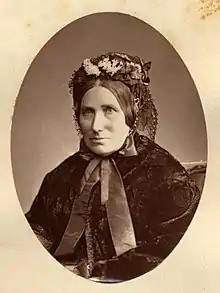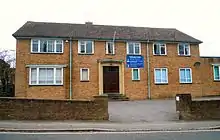Louisa Daniell
Mrs Louisa Daniell (1808/1809–16 September 1871) was a Protestant philanthropist known for her work among the poor of The Midlands but most especially for her Soldiers' Home and Institute in the garrison town of Aldershot in the United Kingdom during the Victorian era.

Early work
Louisa Daniell (née Drake) was orphaned soon after birth. A lonely child, she took comfort in religion.[1] She married Captain Frederick Daniell (died 1837 in India) of the 8th Madras Native Infantry, like herself a devout Christian. After marrying they went to India where they had two children. In India she held prayer meetings and distributed religious tracts.[2] On returning to England after the death of her husband she moved to The Midlands to be near her son Frederick William Daniell who was being educated at Rugby School. Her daughter, Georgiana Fanny Shipley Daniell (1835–1894) who succeeded her mother in her philanthropic work at Aldershot, was educated at Brighton. Deeply moved by the number of destitute vagrants she saw on the streets of Rugby Louisa Daniell set up five missions in five years in the area which were largely financed by local gentry. In these she provided reading rooms and sewing classes and gave out religious tracts and held Bible readings in an attempt to oppose what she saw as the threat of Roman Catholicism.[3][4][5]
Move to Aldershot



By the early 1860s her work at Rugby had brought Daniell to the notice of a Mr Wilson, the Secretary of the County Towns Mission Society, who implored her to “adopt Aldershot”[6] and “work it in the same way as her existing mission stations”.[4] Aldershot had few distractions for the 15,000 troops stationed there other than 18 canteens in the Camp where beer was served and 25 public houses and 47 beer houses in the town, most of which were also brothels where disease was rife. Daniell described Aldershot at this time as "one of Satan's strongholds".[7]
Mrs Daniell and her daughter arrived in Aldershot in April 1862 with the intention of setting up a place of recreation and relaxation for soldiers other than the public houses and saloons;[8] with the help and guidance of some of the outstanding evangelical philanthropists of the period including Lord Shaftesbury they rented a house in Artillery Terrace in October 1862[8] and fitted it up as a mission hall and reading room, providing recreation for soldiers in Aldershot out of concern for their spiritual needs and well-being. The building of her permanent Mission Hall and Soldiers' Home and Institute situated on Barrack Road was commenced in February 1863 on a plot of land donated by local businessman Mr Eggar, being officially opened on 11 October 1863 by Lord Shaftesbury. This building was in the Elizabethan style and consisted of a lecture hall seating up to 500 for religious services, a tea and coffee bar, a smoking and games room, a reading room where newspapers were provided and a lending library in addition to a classroom capable of holding 150 people. Upstairs was the drawing room for use by officers and their families, while other rooms included a kitchen and living accommodation.[3][4]
When the Home first opened it was not thought appropriate for ladies to make such a place their home and a Council of Management was appointed to run it consisting of officers and their wives, representatives from the town and a small staff of volunteers. This arrangement did not work and by 1864 Mrs Daniell and her daughter were back, and stayed for the rest of their lives.[8] Her Total Abstinence Society was set up 1863 and within a year had 500 members, and while many lapsed either temporarily or permanently it held regular meetings and awarded medals to men who kept the pledge.
In addition to the soldiers Mrs Daniells endeavoured to help their wives also. At this time soldiers' wives were either "on the strength" meaning they had basic food and accommodation provided by the Army, or they were "off the strength" meaning they received nothing so their husbands had to provide for them from their low wages. This resulted in extreme poverty in Aldershot's West End where many of these women lived with their children. To help them Mrs Daniell organised Mothers’ Meetings and sewing classes where the women learned to sew clothes which they could then sell at the Mission Hall thus enabling them to earn three or four shillings a week. Mrs Daniell also set up a weekly savings club for the wives where they could put aside small sums to pay for clothing, shoes and other essentials.[4]
Mrs Daniell set up a “Band of Hope” for local children which provided activities and basic education. In 1868 she took over the vacant public house the Wellington Arms in the West End which had a dance hall which could be used as a schoolroom. Here between 50 and 60 children aged 6 to 12 years of age received a basic education in reading and writing, taught by women from the Mission Hall.
Mrs Louisa Daniell died on 16 September 1871 at the family home, Eastwick House in Great Malvern, where she was being treated for breast cancer. Her body lay in state at the Aldershot Mission Hall before being taken for burial at Aldershot Military Cemetery with an escort of Royal Engineers.[9] She is one of the few civilians buried in Aldershot Military Cemetery.
Miss Daniell

Miss Georgiana Fanny Shipley Daniell (20 May 1835 – 24 June 1894) was born in India to Louisa Daniell and Captain Frederick Daniell. She never married and was known as 'Miss Daniell' in Aldershot where, assisted by Miss Kate Hanson (1834–1913), one of the volunteer workers, she continued and expanded her mother's work, raising £30,000 to open further Miss Daniell's Soldiers' Homes at Weedon (1873), Colchester (1873), Manchester (1874), Plymouth (1874), Chatham (1876) and London (1890). She fought tirelessly on behalf of serving soldiers and their wives and children in addition to promoting foreign missionary activities - earning her the name "the Soldiers' Friend".[3][4]
Georgiana Daniell died in the Mission Hall and Soldiers' Home in Barrack Road in Aldershot from an illness brought on by influenza on 24 June 1894. On 29 June her coffin was carried on a gun carriage for burial with her mother in Aldershot Military Cemetery. Miss Kate Hanson carried on the work as Honorary Superintendent of all Mrs Daniell’s Soldiers’ Homes until she died from heart failure on 22 April 1913, aged 79. In recognition of her long service to the soldiers and their wives and children of the British Army she too was buried in Aldershot Military Cemetery, beside the grave of Louisa and Georgiana Daniell.[4]
Miss Daniell's Soldiers' Home in Aldershot

Much of Miss Daniell's Soldiers’ Home in Barrack Road in Aldershot was demolished in 1958, leaving only three walls and a roof from the main hall where the religious services had been held. In 1962 this derelict building was adopted by the Freemasons of Aldershot as a Masonic Hall by building a fourth wall to secure the building. They obtained the building on a 99-year lease from November 1962 and today it is a meeting place for twelve Masonic Lodges and associated organisations.[10]
A new Soldiers’ Home, Havelock House, was built on the site of the former Home and Institute and was opened by Elizabeth II in 1963 on the centenary of the original Miss Daniell's Soldiers' Home. Today it is the headquarters of the Soldiers’ and Airmen’s Scripture Reading Association (SASRA) who are the trustees of Miss Daniell’s Soldiers' Homes, a registered charity[11] with the aim of “Spreading the Gospel of Jesus Christ to personnel in the British Army through provision of physical and spiritual sustenance.”[4]
References
- Cathy Hartley, A Historical Dictionary of British Women, Europa Publications (2003) - Google Books pgs 263-4
- Hartley, C. (2003). A Historical Dictionary of British Women. Taylor & Francis Books Limited. p. 128. ISBN 9781857432282. Retrieved 27 Nov 2016.
- Edward M. Spiers, ‘Daniell, Louisa (1808/9–1871)’, Oxford Dictionary of National Biography, Oxford University Press, 2004 accessed 26 Nov 2016
- Paul Vickers. "A public-house without the drink: the early days of Miss Daniell's Soldiers' Home". Friends of the Aldershot Military Museum - Garrison Herald Articles - 004. Retrieved 27 Nov 2016.
- John Walters, Aldershot Review, Jarrolds (1970) p42
- Walters, pg43
- G. Daniell, Aldershot: A Record of Mrs Daniell's Work Amongst Soldiers and its Sequel (1879) p26
- Howard N. Cole, The Story of Aldershot: a History of the Civil and Military Towns, Gale & Polden, Aldershot (1951) p151
- Walters, p54
- Freemasonry in Aldershot - Aldershot Masonic Centre website
- "Miss Daniell's Soldiers' Homes – Armed Forces Charities website". armedforcescharities.org.uk. Retrieved 27 Nov 2016.
